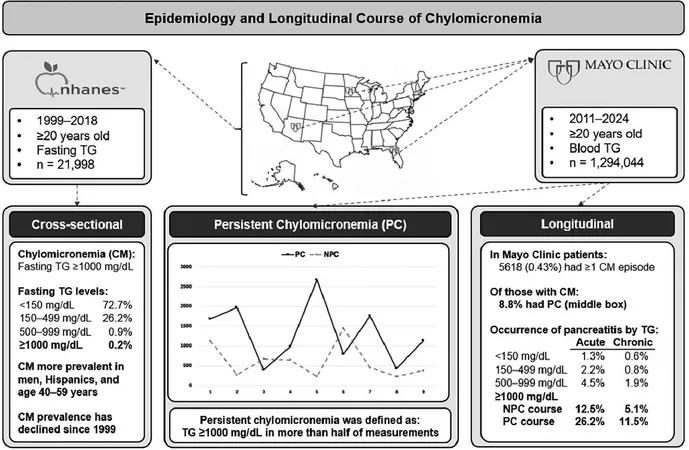
Unveiling the Hidden Dangers of Chylomicronemia: New Study Reveals Critical Insights
2025-03-28
Author: Jia
Introduction
Triglycerides are essential for our body's energy needs, but when their levels skyrocket, they can precipitate severe health issues, including life-threatening pancreatitis. One particularly concerning condition is chylomicronemia, a rare disorder characterized by dangerously high triglyceride levels exceeding 1,000 mg/dL. This alarming condition raises the stakes for serious complications, making it crucial for individuals to understand their risks.
Research Study Overview
A groundbreaking study titled "Epidemiology and Longitudinal Course of Chylomicronemia: Insights from NHANES and a Large Health Care System," published in the esteemed Journal of Clinical Lipidology, marks a pivotal moment in our understanding of this disorder. Led by a team of researchers at Baylor College of Medicine, this comprehensive analysis sheds light on the prevalence, risk factors, and long-term implications of chylomicronemia, providing healthcare providers with critical tools to enhance patient care.
Key Findings
By meticulously examining data from nearly 22,000 adults in the National Health and Nutrition Examination Survey (NHANES) and over 1.2 million patients within the Mayo Clinic health system, the researchers found that chylomicronemia affects approximately 1 in every 500 adults in the U.S. This statistic underscores the significance of this condition within the population and emphasizes the need for heightened awareness.
Notably, the study reveals that certain demographics are at a greater risk, particularly men, individuals between the ages of 40 to 59, and those belonging to Hispanic communities. However, only about 8.8% of identified cases, roughly 1 in 5,500 individuals, go on to experience persistent chylomicronemia. This chronic variant poses the highest risk for developing pancreatitis, necessitating vigilant monitoring and intervention.
Expert Insights
Dr. Christie M. Ballantyne, a prominent figure in cardiovascular research at Baylor, emphasized the clinical relevance of these findings: "Our research provides a pragmatic approach to identifying and managing patients at the highest risk for pancreatitis and other complications. By understanding the long-term course of this condition, we can better target emerging therapies to those who need them most."
The implications of this study extend far beyond mere statistics. Healthcare professionals are now equipped with better strategies for recognizing and managing chylomicronemia. With a clearer comprehension of prevalence and risk factors, doctors can pinpoint patients who may need closer monitoring and follow-up triglyceride assessments. Furthermore, as treatment landscapes evolve, there is hope on the horizon for therapeutic agents specifically designed for patients with persistent chylomicronemia.
Looking Ahead
Dr. Seyedmohammad Saadatagah, the lead author of the study, also added, "Persistent chylomicronemia is a clear indicator of increased risk for severe disease. By shifting focus from a singular triglyceride measurement to long-term trends, we can more effectively identify patients who require aggressive intervention."
As research into lipid disorders progresses, studies like this are essential for shaping future treatment strategies. With promising new therapies on the cusp of introduction, these insights will serve as a beacon for more targeted and effective interventions, ultimately safeguarding the health of high-risk populations. This unfolding narrative not only highlights the significance of chylomicronemia but also emphasizes the urgent need for increased awareness and proactive management in the medical community.





 Brasil (PT)
Brasil (PT)
 Canada (EN)
Canada (EN)
 Chile (ES)
Chile (ES)
 Česko (CS)
Česko (CS)
 대한민국 (KO)
대한민국 (KO)
 España (ES)
España (ES)
 France (FR)
France (FR)
 Hong Kong (EN)
Hong Kong (EN)
 Italia (IT)
Italia (IT)
 日本 (JA)
日本 (JA)
 Magyarország (HU)
Magyarország (HU)
 Norge (NO)
Norge (NO)
 Polska (PL)
Polska (PL)
 Schweiz (DE)
Schweiz (DE)
 Singapore (EN)
Singapore (EN)
 Sverige (SV)
Sverige (SV)
 Suomi (FI)
Suomi (FI)
 Türkiye (TR)
Türkiye (TR)
 الإمارات العربية المتحدة (AR)
الإمارات العربية المتحدة (AR)